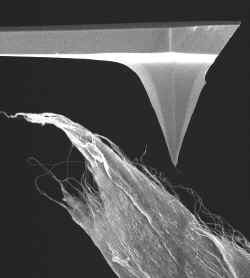Carbon Stretched to the Breaking Point

Carbon nanotubes are said to be stronger than the high-tech composites used in the Space Shuttle. But it’s hard to directly measure the mechanical properties of these 1-nm-diameter, pure carbon tubes, so the estimates have relied upon computer simulations and a few indirect experiments. A U.S. team has now made the most direct measurements of their strength and reports the results in the 12 June PRL. They measured the force it took to stretch “ropes” of nanotubes until they broke, while recording the increase in length simultaneously. The results confirm that nanotubes are among the strongest of all known materials, and the measurement technique is likely to lead to a more detailed characterization of nanotubes in the future.
Nanotubes have a rare combination of high strength and high stiffness, two properties engineers (and pilots) want in materials for airplanes and satellites, but they may also be good for making nanomachines of the future, or tools for manipulating tiny machines. The mechanical properties of nanotubes also influence other potential uses, such as in electronics, where the change in conductance brought on by squashing a nanotube could be used in tiny circuits. Although individual, single-walled nanotubes are still too small to measure, Rodney Ruoff of Washington University in St. Louis and his colleagues recently stretch tested multiwalled nanotubes–nested tubes, 20 to 40 nm in diameter. Now they have done it with collections of single-walled tubes of about the same total diameter.
Using standard techniques, the team prepared pieces of “Buckytube paper” made of almost pure nanotubes and tore them to make rough edges. After placing one of these inside a scanning electron microscope (SEM), they maneuvered a sharp-tipped atomic force probe into contact with one of the nanotube ropes protruding from a rough edge, while watching continuously with the SEM. Using an old SEM adhesion trick, the researchers then focused the SEM electron beam at the contact point to dissociate residual gas phase hydrocarbons from the imperfect vacuum and “glue” the tubes to the probe.
As they stretched a nanotube rope, the team measured the probe’s deflection to find the stretching force up to the breaking point, and in half of their attempts they saw dark impurity particles on the ropes with which to measure their length change. On average they found that 30 to 50 GPa of stress was needed to break a single nanotube, assuming several hundred tubes per rope. Carbon fibers used in the aerospace and sporting equipment industries can take only about 5 GPa, while steel breaks at 3 GPa. Ruoff and his colleagues measured an average stiffness of about 1000 GPa, which is also high compared with common materials. Both values are in line with theoretical predictions for nanotubes, although the strength predictions vary widely because it’s difficult to simulate a slowly stretched nanotube.
Boris Yakobson of Rice University in Houston says the results are important because they show that extremely strong individual tubes exist–as strong as 52 GPa–which was clear only indirectly from past experiments. The stretch-to-breaking tests also show that force can be efficiently transferred from the macroscopic realm to the nanotubes, he says. Ruoff says many more measurements of nanotubes under a variety of different conditions are needed in the near future, as well as tests of single nanotubes–a challenge his team is currently pursuing.


